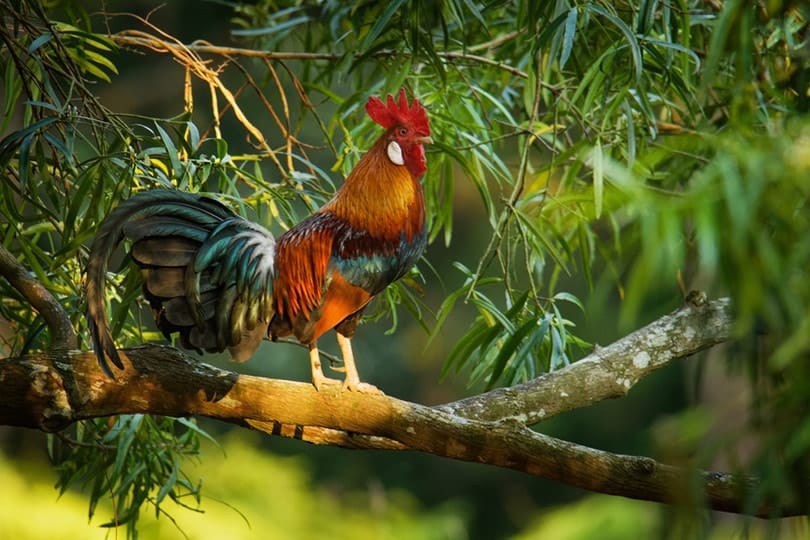Many people are becoming more interested in keeping chickens, but the domestic chicken’s wild cousin, the Red Jungle Fowl, is often overlooked. However, they are great layers and are often considered hardier than most chickens, but they can be quite shy and don’t seem to appreciate the company of humans. Here’s everything you need to know about the Red Jungle Fowl Chicken.

Quick Facts about Red Jungle Fowl Chicken
| Breed Name: | Spanish Gamecock |
| Place of Origin: | Southeast Asia |
| Uses: | Meat, eggs |
| Rooster (Male) Size: | 3.25 pounds |
| Hen (Female) Size: | 2.25 pounds |
| Color: | Red, orange, gold, green, white, grey |
| Lifespan: | 10–30 years |
| Climate Tolerance: | Tropical but tolerant to cold |
| Care Level: | Easy |
| Production: | Moderate to high |
Red Jungle Fowl Chicken Origins
Native to part of Southeast and South Asia, the Red Jungle Fowl has been around for thousands of years. It’s estimated that around 7,000–8,000 years ago, people in the area began domesticating and crossbreeding different species of Jungle Fowl, eventually creating the domestic chicken. The Red Jungle Fowl still exists in its natural environment, though.

Red Jungle Fowl Chicken Characteristics
These birds are smaller than most breeds of domestic chickens, with roosters only weighing about 3.25 pounds and hens only weighing about 2.25 pounds. The roosters can reach up to 30 inches in length, with around one third of that length consisting of long, luxurious tail feathers. The hens may reach similar body lengths to the roosters, but they do not develop such long tail feathers.
The Red Jungle Fowl is a shy bird, often preferring to stay away from humans. This applies to wild and domestic Red Jungle Fowl alike. They are relatively docile birds that would rather run than fight when threatened. They prefer to stick to the edges of clearings, which allows them to forage for food while maintaining a safe distance from potential danger and a quick escape route.
Many keepers report these birds to be hardier than most domestic chickens, tolerating a wide range of temperatures. Both wild and domestic Red Jungle Fowl are used for meat and eggs, and the beautiful feathers of the roosters can be used for decorative purposes as well.
Uses
Most keepers report these birds to be prolific egg layers, with hens laying up to 300 eggs per year in captivity. During the laying season, hens will lay an egg every day. In a climate-controlled environment, hens may lay daily eggs for most of the year. In cooler climates, they will lay fewer eggs because they will not lay in cold weather when there is a low chance of offspring survival. Although smaller than most domestic chickens, Red Jungle Fowl lay medium-sized eggs. These birds are also used for meat, although their small, athletic build doesn’t make them ideal meat producers.

Appearance & Varieties
The Red Jungle Fowl sports a rainbow of colors with feathers ranging from reds, oranges, and golds, to grey, white, and shades of greens. The roosters often develop metallic green feathers, especially on the tail. These birds are distinctly chicken-like in appearance, to the point that if you saw one in the wild, you wouldn’t question if it was a chicken of some sort.
Population, Distribution & Habitat
These birds are native to Southeast Asia and some parts of South Asia. They are naturally accustomed to the humid, warm environment of Southeast Asia, but they are tolerant of colder and drier climates as well. Although they still live in the wild in Southeast and South Asia, the Red Jungle Fowl has a nearly worldwide presence in hobby farms.

Are Red Jungle Fowl Chicken Good for Small-Scale Farming?
If you’re interested in adding prolific egg layers to your small-scale farm, the Red Jungle Fowl may be a great option. Their small size, hardy nature, and standoffishness makes them relatively easy to care for, especially in free-range settings. They aren’t the top pick for meat birds since they are on the small side, but they can be used for this purpose if desired.
See Also
Featured Image Credit: DuyCuong1080, Pixabay
